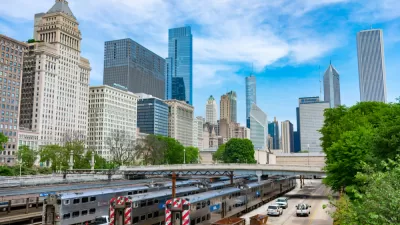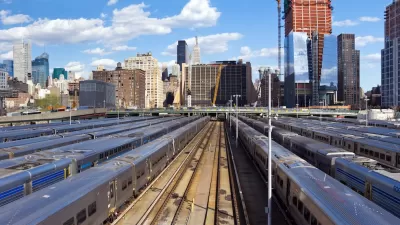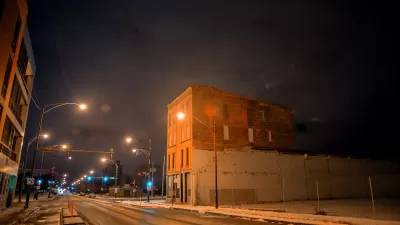Transit-oriented development has ramped up in Chicago, but racial and economic inequities have come along with it. A proposed ordinance would expand TOD zones while also preventing displacement of residents.

Chicago passed a transit-oriented development ordinance in 2013 as well as an initiative last year focused on TODs along high-ridership bus corridors in the city. "If a land parcel is located within a quarter-mile (two full blocks or a roughly five-minute walk) of a designated bus line segment, that parcel is eligible for reductions in required parking and increases in height and density," reports David Zegeye.
As these projects have moved forward, however, concerns about displacement in low-income communities and communities of color have become an issue, particularly in areas where upscale TOD projects mean less affordable housing. Mayor Rahm Emanuel last week introduced a new ordinance to expand the city’s TOD zones and support equitable TOD, says Zegeye:
Unlike previous versions of Chicago’s TOD ordinance, the new legislation explicitly mentions using TOD as a strategy for increasing racial and economic equity. Stated goals include "Avoiding displacement of residents, small businesses, cultural institutions, and community organizations" and "Encouraging investment in communities of color and low-income communities and appropriately addressing various market conditions."
The goal of the ordinance is to encourage TODs in underserved parts of the city, including Chicago's South Side and West Side neighborhoods. The TOD bus corridors also align with areas the city hopes to revitalize using local economic development and federal Opportunity Zone funding.
FULL STORY: How Chicago’s New Bus TOD Ordinance Could Help Underserved Communities

Manufactured Crisis: Losing the Nation’s Largest Source of Unsubsidized Affordable Housing
Manufactured housing communities have long been an affordable housing option for millions of people living in the U.S., but that affordability is disappearing rapidly. How did we get here?

Americans May Be Stuck — But Why?
Americans are moving a lot less than they once did, and that is a problem. While Yoni Applebaum, in his highly-publicized article Stuck, gets the reasons badly wrong, it's still important to ask: why are we moving so much less than before?

Using Old Oil and Gas Wells for Green Energy Storage
Penn State researchers have found that repurposing abandoned oil and gas wells for geothermal-assisted compressed-air energy storage can boost efficiency, reduce environmental risks, and support clean energy and job transitions.

Greening Oakland’s School Grounds
With help from community partners like the Trust for Public Land, Oakland Unified School District is turning barren, asphalt-covered schoolyards into vibrant, green spaces that support outdoor learning, play, and student well-being.

California Governor Suspends CEQA Reviews for Utilities in Fire Areas
Utility restoration efforts in areas affected by the January wildfires in Los Angeles will be exempt from environmental regulations to speed up the rebuilding of essential infrastructure.

Native American Communities Prepare to Lead on Environmental Stewardship
In the face of federal threats to public lands and conservation efforts, indigenous groups continue to model nature-centered conservation efforts.
Urban Design for Planners 1: Software Tools
This six-course series explores essential urban design concepts using open source software and equips planners with the tools they need to participate fully in the urban design process.
Planning for Universal Design
Learn the tools for implementing Universal Design in planning regulations.
Heyer Gruel & Associates PA
City of Moreno Valley
Institute for Housing and Urban Development Studies (IHS)
City of Grandview
Harvard GSD Executive Education
Salt Lake City
NYU Wagner Graduate School of Public Service
City of Cambridge, Maryland





























